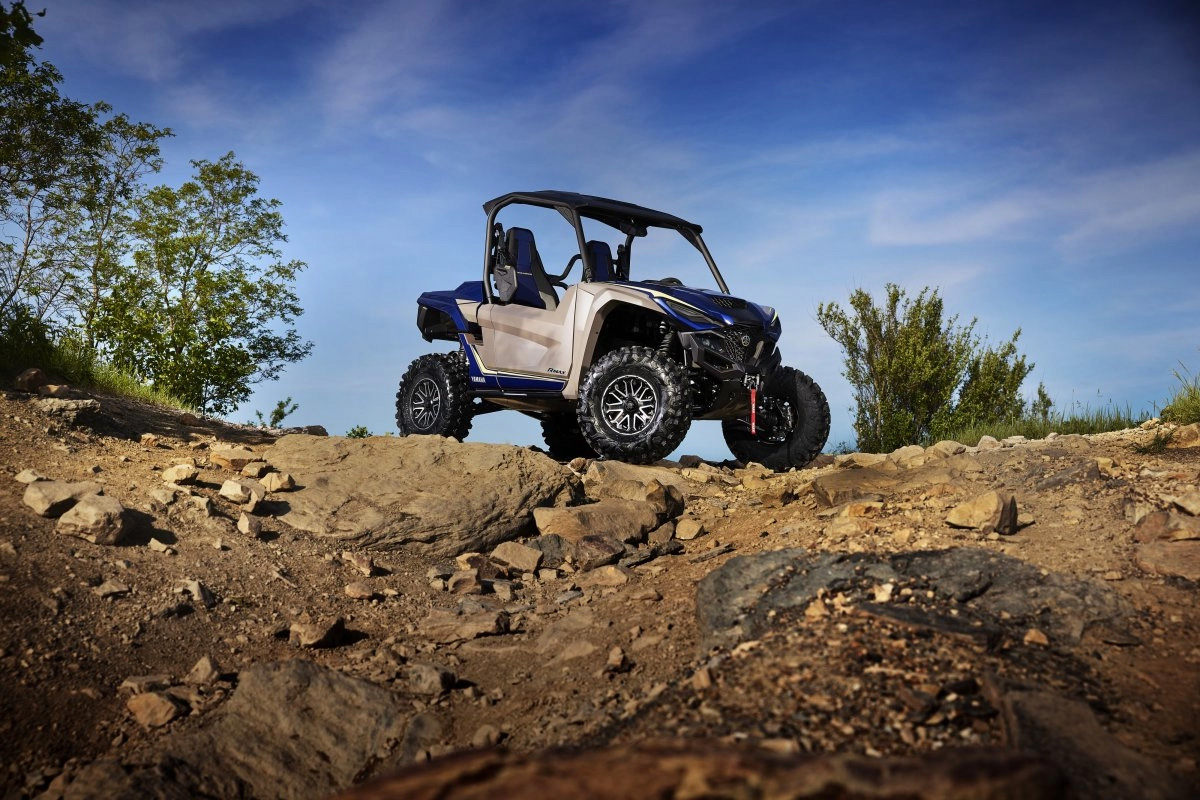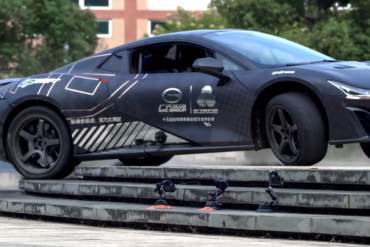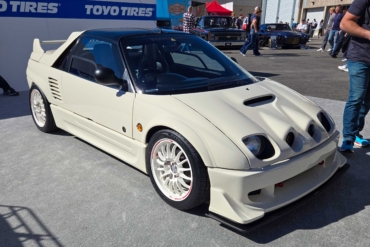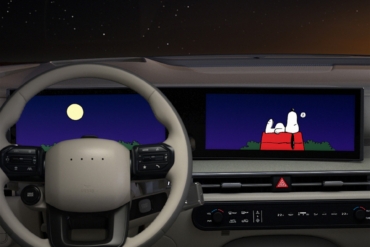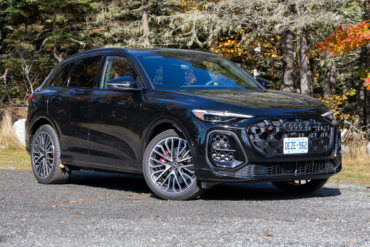New for 2023, RMAX 1000 trims can come with a full-cab enclosure addition to shelter passengers from wind, rain, and sideways snow — all of which hit us during testing in California’s Rattlesnake Canyon.
When you’re out on an all-day drive in your UTV, you’re in the weather, for better or worse. If it starts raining — or, as was the case this year in California, snowing sideways — you’ll be soaked and cold soon enough.
That’s what makes Yamaha’s full-cab kit ideal. I got to test out the Wolverine RMAX2 1000 LE with Yamaha’s full-cab accessories installed. A glass front windshield and wiper blade system, rear sliding glass window, and full, lockable doors, along with the Cab Heater Kit, kept me and my passenger toasty and dry on this chilly, wet day.
In short: Yamaha’s Wolverine RMAX2 1000 LE with full-cab accessories can hugely extend your off roading in all weather conditions. However, a significant issue I found with the cab kit was condensation buildup.
- Displacement: 999cc
- Engine: DOHC, liquid-cooled, 4-stroke parallel twin; 4-valve
- Drivetrain: On-Command 3-way locking differential; 2WD, 4WD, full differential lock 4WD
- Front suspension: FOX iQS piggyback shocks; 14.2" travel
- Rear suspension: FOX iQS piggyback shocks; 16.9" travel
- Front brakes: Dual hydraulic 255mm discs, 32mm dual-piston calipers
- Rear brakes: Dual hydraulic 244.5mm discs, 27mm dual-piston calipers
- Wheelbase: 86.7"
- Towing capacity: 2,000 lbs., 2" receiver
- Cargo bed capacity: 600 lbs.
- Ground clearance: 13.8"
- Wet weight: 1,885 lbs.
- Fuel capacity: 9.2 gals.
2023 Yamaha Wolverine RMAX2 1000 LE Review
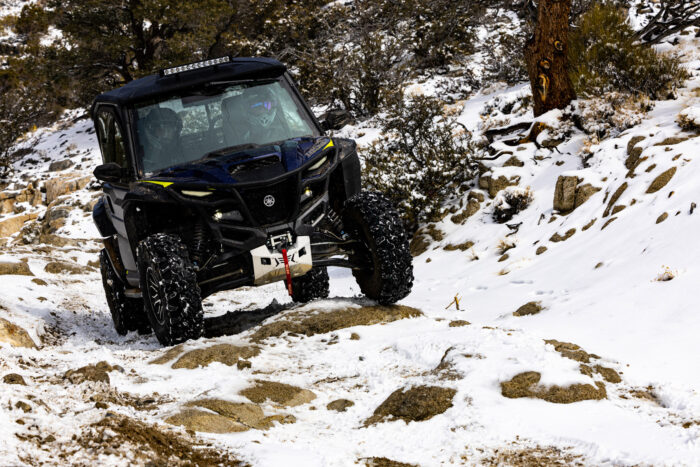
Without the full-cab add-ons, the Wolverine RMAX2 1000 LE is open to the elements: no windshield, full-size doors, overfenders, heater, or other accessories sheltering you against the elements. It’s fine for when you only play or work in nice weather. But, what if you’re out on not-so-perfect days? Or, ranching someplace where bad weather doesn’t mean no work? Well, that’s a different story.
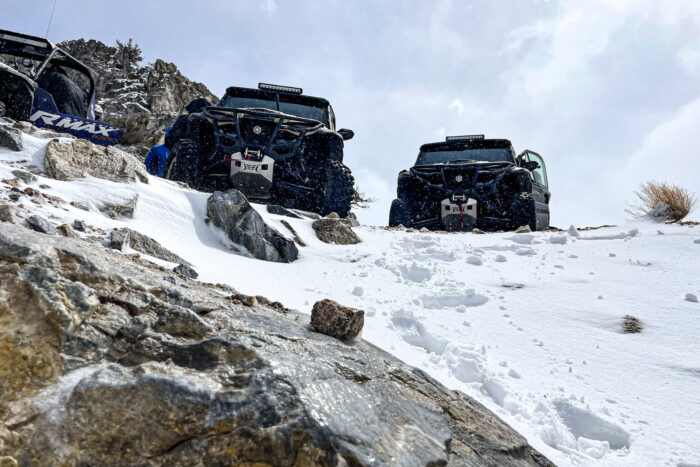
The RMAX2 1000 LEs get a 999cc parallel-twin engine, FOX iQS suspension, three drive modes, and the industry’s only 10-year belt warranty. Each UTV also comes with terrain-focused tires, “best-in-class” ground clearance, a WARN winch, and a tilting cargo bed.
Although my testing time was recreation-based and purely for the fun of driving a UTV, let’s not discount another strong argument for owning a Wolverine: ranching, farming, people with acreage, or long driveways … this RMAX 1000 is set up for a heavy-lifting life at home, too.
RMAX2 1000 LE Engine & Transmission
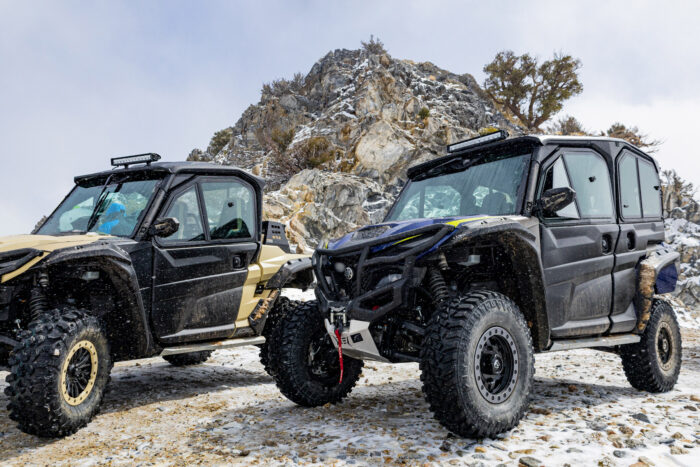
The Wolverine uses the same 999cc DOHC parallel-twin engine as the 2022 model. A purpose-built centrifugal wet clutch and a constant-tension system pass through Yamaha’s Ultramatic V-belt, which allows the Wolverine to function in high-rev range without damaging the belt.
The Wolverine RMAX2 1000 Limited Edition is also equipped with Yamaha’s Speed Management System, which limits the SxS to a top speed of 25 mph — ideal for work sites or when your teenager gets ahold of the keys. Yamaha says the Speed Management System won’t sacrifice full power from the engine.
Because of many variables, Yamaha doesn’t provide top-speed numbers. But a stock RMAX2 1000 can go at least 74 mph.
3 D-Modes: Crawl, Trail, Sport
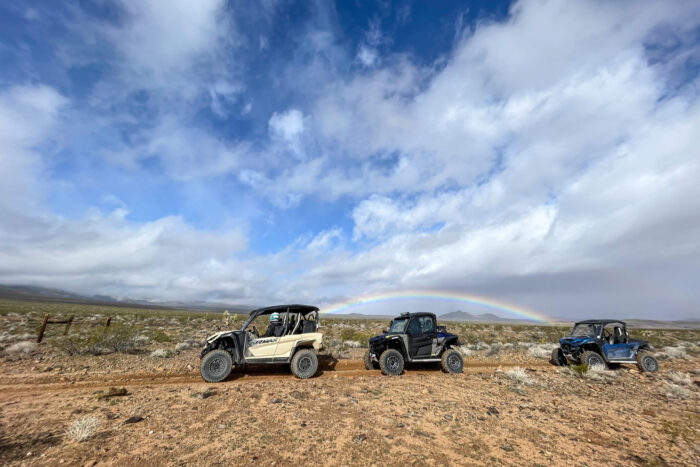
I started out with the RMAX2 in “Comfort” mode for the suspension and in the “Crawl” D-mode for travel.
After getting my bearings, I switched things up while driving over some hard-packed washboard and whoops. Increasing speed, I choose “Firm” for suspension, while clicking into “Trail” mode.
All of this was done from my seat at any speed and wearing thick gloves. The D-modes are easy to click through by simply turning a knob located to the right of the steering wheel.
The suspension button is located on the dash and was also just a matter of clicking into position. That button was a little harder to articulate wearing fat-finger gloves. If Yamaha were to add a heated steering wheel to the kit, drivers could use thinner gloves for better dexterity.
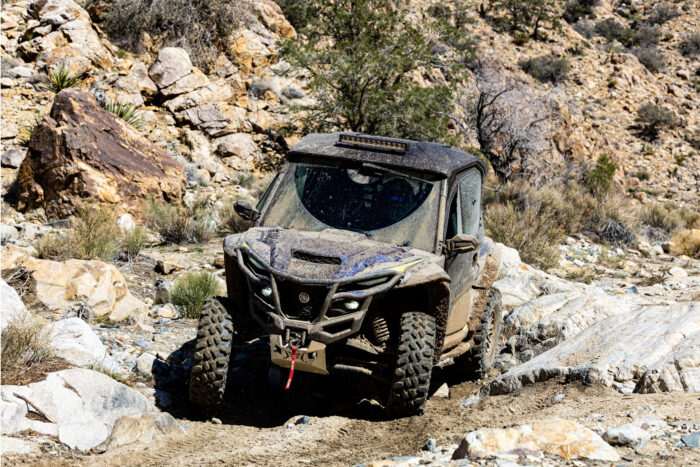
The difference between Crawl mode and Trail was subtle — at least when I tried to switch it mid-drive, which you can do. In Crawl mode, you won’t be kicking up any dust out of the gate. It’s designed to tractor forward with a delayed kick-in. Think “Eco” mode in a vehicle.
Trail mode will give you more of a burst, say for when you’re bogging down on something steep or deep, and need more power than Crawl, but don’t want the shot-out-of-a-cannon-feeling Sport mode offers.
Sport mode is indeed sporty. I used that on some of the twistier, sandy sections, and absolutely felt the difference in power distribution throughout. Everything tucked in for a solid feel, inspiring confidence, even skipping at high speeds over the hard-packed desert floor.
In all three modes, you’ll have 100% power, which some of Yamaha’s competitors can’t claim.
Suspension: Comfort, Medium, Firm
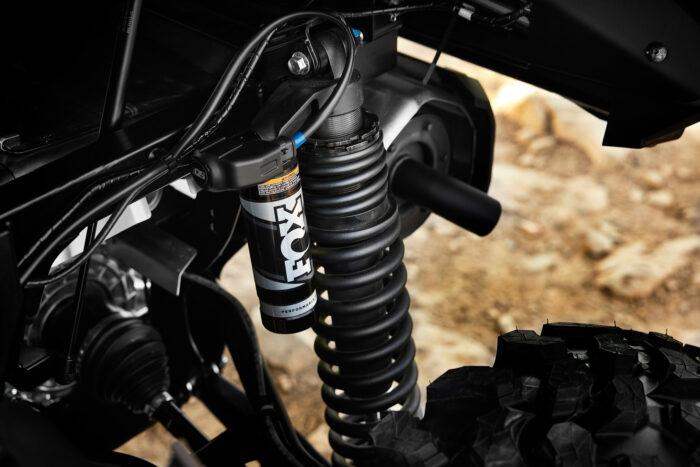
The LE comes with FOX iQS piggyback shocks with electronic shock-damping control. As mentioned, adjusting stiffness is all within reach on the fly with the click of a button.
When I was driving on harder surfaces with speed, I toggled between the Firm and Comfort modes. Comfort gave a softer ride but felt less stable than Firm.
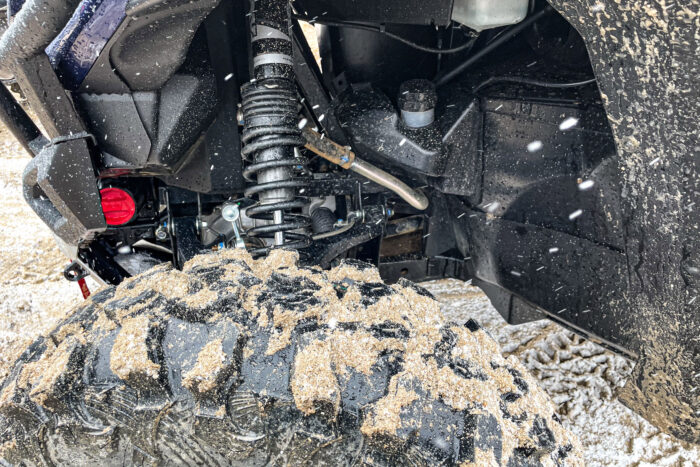
For most of the ride, I kept the suspension in Medium, which tackled everything smoothly, from whoops to rock climbing to deep sand.
Yamaha’s Dash-Integrated Adventure Pro

Your mode and suspension choices will appear on the easy-to-read 7-inch Adventure Pro screen, which is integrated into the dash and is lockable and removable.
The Adventure Pro is customizable and comes with GPS mapping and navigation, along with over 115,000 preloaded trails and waypoints.
You can also share your rides on social media and with friends and family.
Tires & Brakes: A Winning Combination
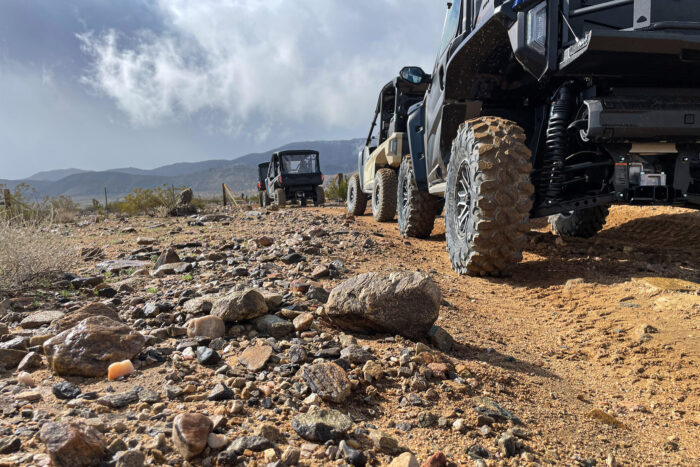
Like a vehicle, all tires on the RMAX 1000 are four-square — convenient for carrying spares, especially since there isn’t much room on or in a SxS.
Each LE model comes stock with 30-inch Maxxis Carnivore tires and 14-inch aluminum wheels. The sidewall was incredibly tough, even after repeat hits on some of the sharper rocks in Rattlesnake Canyon.
We started out driving into the eye of the storm. At first, it was just rainy, but after gaining higher elevations, our group was soon into the snow. I never once felt any concern driving up or down the steep, wet roads, and never felt the tires slip.
All RMAX 1000 trims get a front anti-sway bar and all four corners have hydraulic disc brakes.
The braking system has 255mm rotors and 32mm dual-piston calipers in the front, and 244.5mm rotors and 27mm dual-piston calipers in the rear with a master cylinder and premium steel-braided brake lines.
A one-way sprag clutch offers drivers engine braking at any speed — ideal when coming off the summit after our snowy lunch stop at 7,200 feet.
What’s Inside?
This is where comfort is most important, and Yamaha has given its customers some excellent cab features.
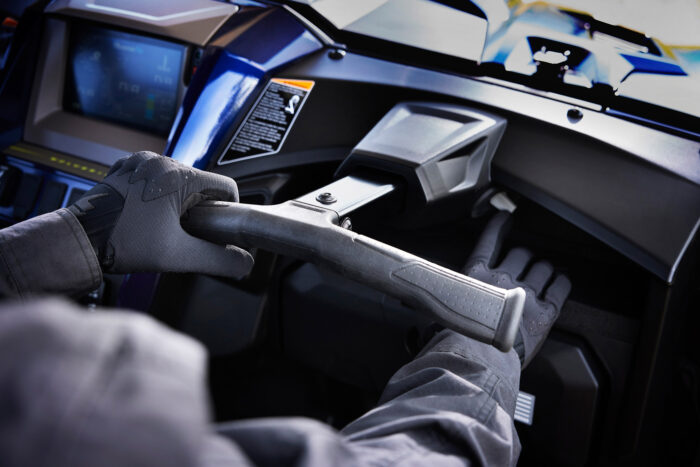
Drivers do get the option to adjust their seat and the steering wheel. Passengers do not get adjustable seats but can adjust the grab bar in front of them.
The driver and passenger also have a height-adjustable “no tools needed” seat belt shoulder strap. The seat belt itself is three-point.
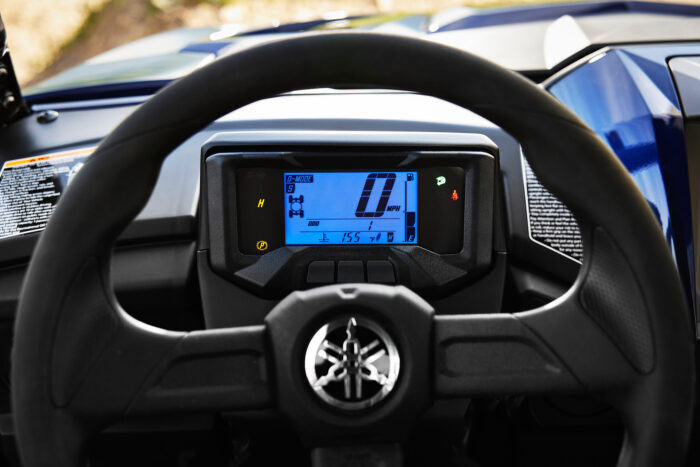
The steering wheel is covered in smooth rubber for comfort and is designed for “thumbs-up” driving so you won’t injure those digits if you suddenly deflect off a rock or something solid.
Soft touch points in the leg areas as well as the steering wheel and center console are a thoughtful addition allowing for increased comfort on bumpy rides.
The seat was firm yet soft and, after a few adjustments, fit my 5’6” frame well. My helmet didn’t bounce off the headrest and I felt snug and secure in the three-point system.
I did find myself grabbing the shoulder bolster before getting into the seat and it got in the way when I tried to get out. My elbow naturally wanted to press on it like I would a car door. Very large or tall folks might find ingress and egress a tight squeeze.
RMAX 1000 Cold-Weather Accessories
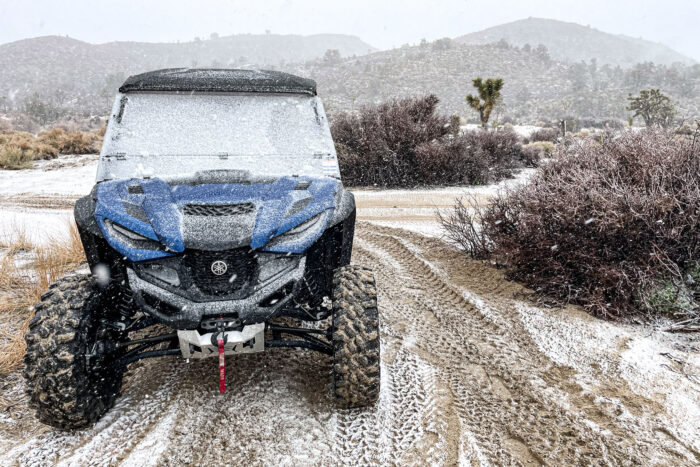
While I drove the RMAX2 1000 LE, there were two other enclosed Wolverine options: the RMAX2 1000 XT-R and the RMAX4 1000 LE.
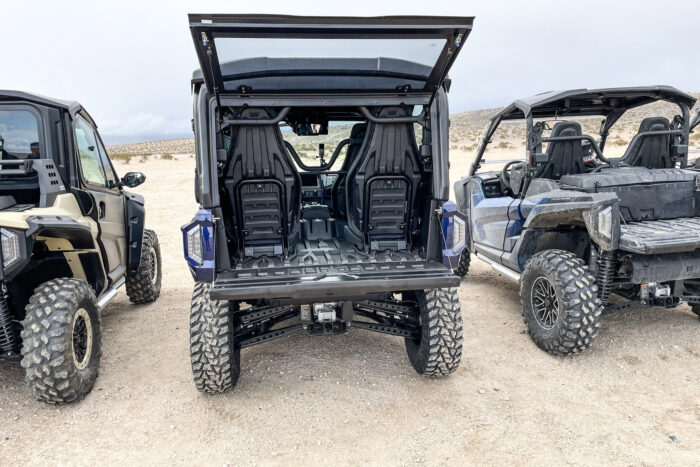
The latter was a four-passenger UTV — great for family rides, with back seats that slide forward for more cargo room or back to seat friends, kids, or pets. Everyone gets adjustable seat belt heights, which is something some competitors don’t offer.
Part of our group included some Yamaha PR folks and a trip leader. None of them were in the full-cab UTVs, and they all looked miserable.
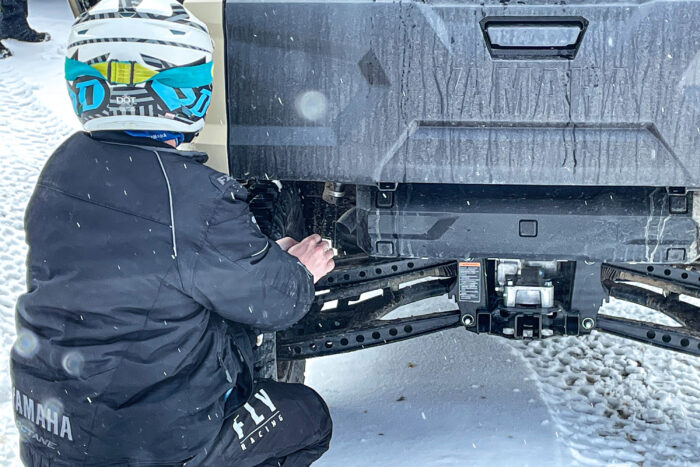
All was great until we hit the mud. The nonenclosed drivers were cold and wet going up the mountain. When the sun came out on the way down, they were covered in mud and spray from melting snow.
Watching these guys shivering and spitting dirt from their teeth was a solid selling point for investing in the full-cab kit.
All RMAX models come with floor drains for easy cleanup.
Yamaha’s RMAX 1000 Full-Cab Kit
- Glass windshield with wiper & washer system: Made from 0.25-inch-thick laminated glass; washer system mounts under the hood.
- Sliding glass rear window: Integrated mounting points; secure latch prevents opening in rough terrain and unauthorized entry; tempered glass.
- Wolverine cab heater kit: 22,000 BTU/hour and a 240 CFM blower for maximum heating comfort; four vents: two defrosting and two dash cab vents; three-position rocker switch.
- Wolverine RMAX 1000 hard front cab door kit: Tinted tempered glass windows; three-position side windows range from a fully closed position to a vented or fully open position; inside and outside dual-cast door latches with outside latch equipped with a keyed lock.
- Overfenders: Protection from mud and water; fits both stock and accessory wheels and tires; made from durable thermos-formed plastic.
- Wolverine rear cargo box: Integrated cup holders; walkable and water resistant; maintains full functionality of tailgate; 24-gallon capacity.
- Yamaha 60W LED light bar (15“): 12 5W Creed LEDs; newly designed wide spot reflector for improved light dispersion over standard light bars; 50,000-hour lifespan; illuminated two-position switch; low power consumption; beam configuration: four wide spot, four spot, four wide spot (15″).
- Wolverine RMAX2 1000 rock sliders: 1/8” of reinforced steel; full-length, plated structure; pair with Full Under Body UHMWPE skid plates (sold separately).
- Wolverine RMAX 1000 front brush guard: complete front coverage that protects headlights and front body panels; all steel 1.5-inch tubing with E-coated and powder coating that matches the RMAX 1000.
- Wolverine RMAX 1000 front bash plate: 1/8” brushed aluminum and 1/8 in. of E-coated and powder-coated steel; maintains full function of tiedown points.
- Sideview mirrors & cab mounts: Wide angle provides optimal distortion-free view; scratch-resistant glass; foldaway.
RMAX 1000 Full-Cab Enclosure Pros
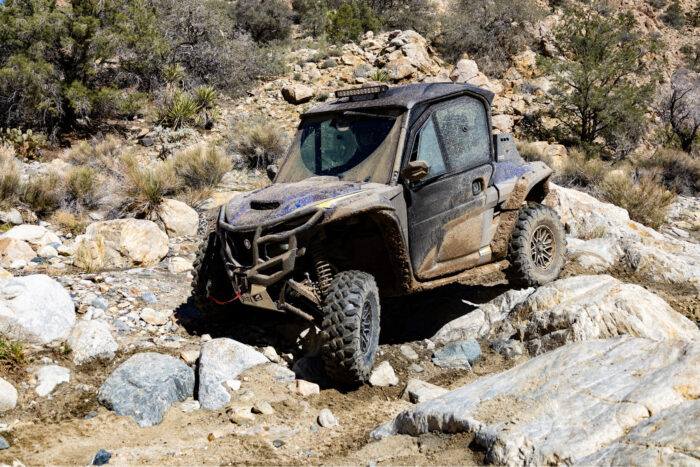
Naturally, shelter from cold, wet weather is a huge plus. We drove over 60 miles and past 7,500 feet — all-day driving in exactly the type of terrain and weather that inspired this SxS enclosure build. And neither the machine nor I complained.
Everything about the design and fit of the full-cab enclosure kit is well thought-out and, Yamaha claims, easy to install. I was comfortable, warm, and had everything I wanted within reach.
The hard-packed washboard was no match for the suspension, which ate up the bumps like I was a rock skipping across a calm lake. Just what you’d expect from a King of Hammers winner.
The power kicked in when I demanded with no shortage of torque and speed.
Full-Cab Enclosure Cons
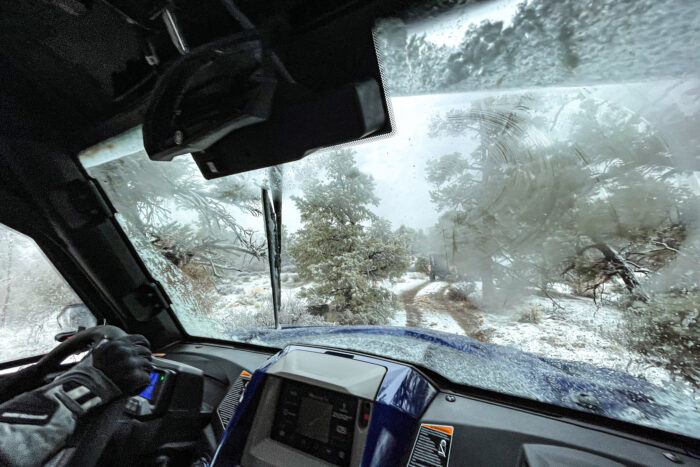
I had two main issues: condensation and blind spots through the windshield.
The condensation was a mix of how wet it was outside versus having the heat cranked on the inside.
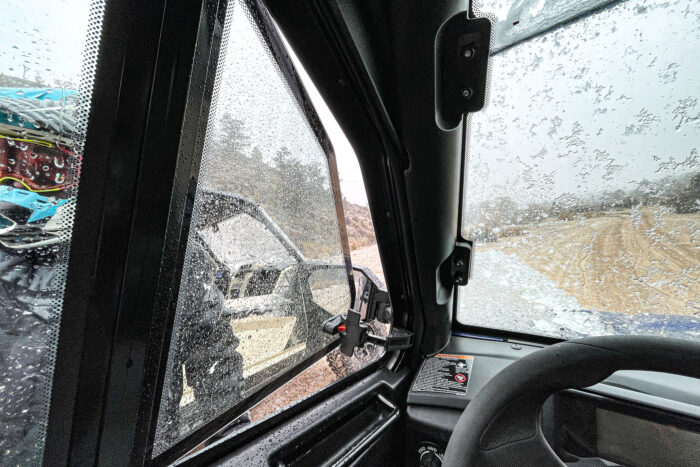
Opening the side windows helped but after some messing about, I discovered closing them and opening the rear slider window was better. This did bring in some cold air, though.
A bigger issue was with the wipers, washing fluid, and dirt buildup on the windscreen.
This was likely a one-off issue, but the wiper’s nut backed off, so the blade was hanging limp until we could fix it.
Next, the washer fluid stopped working, even though the reservoir was full. The airlock was cleared, but it happened again, maybe due to grit buildup.
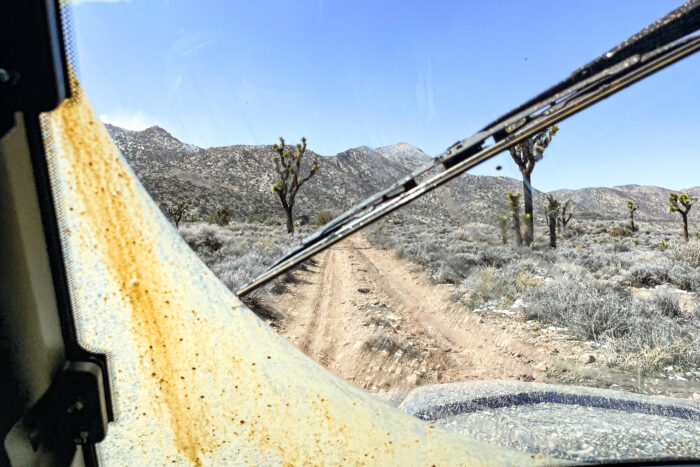
Most notable, as you’ll see in the photo above, was the blind spot areas in the lower corners of the windshield.
A significant portion of the window was obscured with mud and snow buildup because it was a spot the wiper didn’t reach. Being shorter, I had to lean to the right to see around it, especially in tight corners.
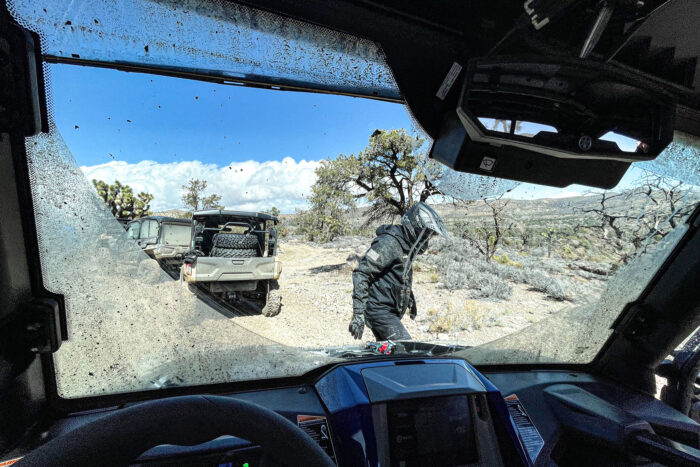
The way the wiper blade sits at the top and wipes in an arc downward causes it to only clear a half-moon-shaped patch. The wiper also smacked the top of the cab’s frame loud enough that it became annoying.
A redesign of the blade to operate more like that of a vehicle — coming from the bottom — could help.
I would have also liked a slower speed for the wiper. It’s intermittent, but even the lower speed was too fast at times. I had to continually take my hand off the wheel to turn the wiper on and off manually.
Other issues were less significant. Since this cab design is intended for cold weather, there is no air-con. There is also limited room in the cab for extra items — even a small backpack.
The full-cab enclosure will add considerable weight and expense, as well. See below for pricing info. As for weight, the enclosure will add 200 pounds if you have the front and rear glass windshield and cab doors.
2023 Wolverine RMAX2 1000 LE Wrapup
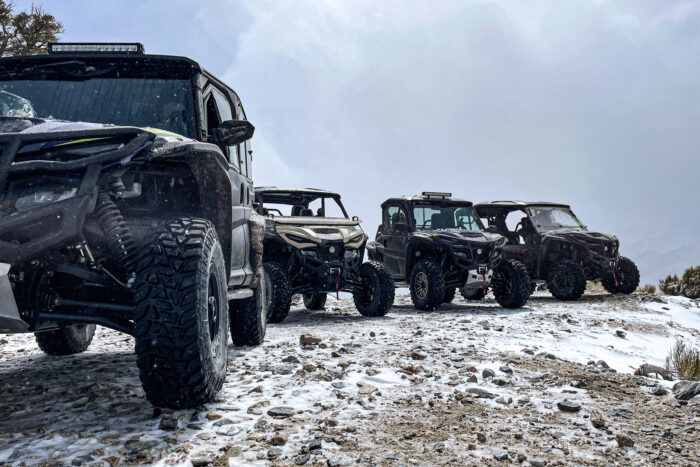
Overall, the Wolverine RMAX 1000 series proved to be excellent machines. They are more than capable of not only keeping drivers and passengers warm and comfortable but also safe and exhilarated.
The cons were minor compared to the luxuries, and let’s be honest — anything that keeps you out there playing for longer is a good thing, right?
Assembled in the U.S., the Wolverine RMAX2 1000 Limited Edition starts at $27,699. The WARN VRX 45 winch, Yamaha’s 7-inch LCD Adventure Pro display, FOX iQS shocks, and higher-grade audio system come stock.
Adding the full-cab enclosure will set you back an additional $3,199.99 for a door kit.
A front windshield with wiper system is $1,414, and a rear glass sliding window is $832.
At the time of writing, Yamaha has the RMAX2 1000 and the accompanying full-cab accessories available. The full-cab accessories can all be purchased separately, as well.
If you want to try before you buy, Yamaha posts public demo opportunities on its website.

